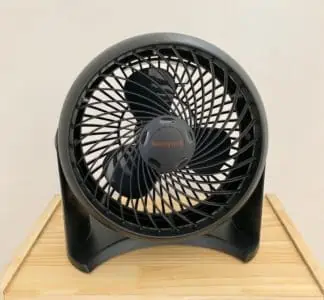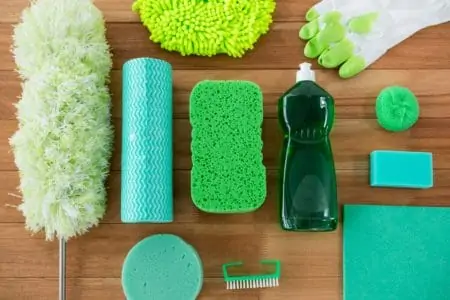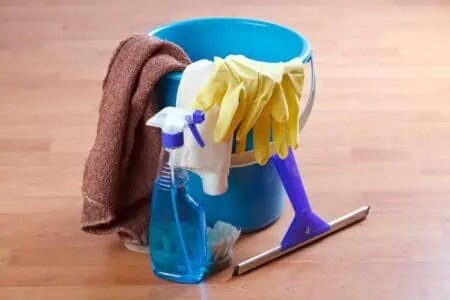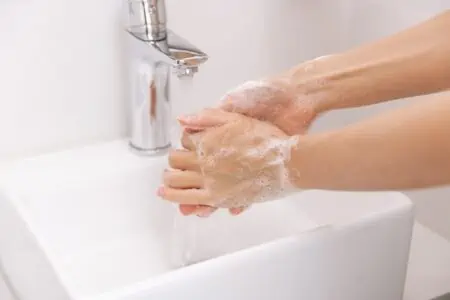If the dust has settled on your Honeywell fan, it’s due to be cleaned. The last thing you need is your fan blowing dust and debris around your home. But where to start?
We’ve put together a comprehensive guide for how to clean a Honeywell fan. This includes a method for disassembly and another method without taking it apart.
So whether you’re feeling like a quick lazy clean or a deeper clean, keep reading for our favorite methods.
Key Takeaways
- Unplug and disassemble the Honeywell fan before cleaning to ensure safety.
- Use a vacuum cleaner, microfiber cloths, and a soapy water solution to clean the fan thoroughly.
- Reassemble the fan and let it air dry completely before using it again.
- Regular cleaning improves fan efficiency and prevents dust buildup.
Safety Precautions
Before you get started, it’s essential to make sure you aren’t taking any risks. You should ensure a few main details before you begin.
- Make sure the fan is unplugged. You don’t want any electricity running through the fan while you’re cleaning. Unplug the fan and let it sit for around 30 minutes to drain any electricity.
- Work in a well-ventilated area. Chances are there will be quite a lot of dust loosening as you clean. So, if you can, work outdoors or near a window, your lungs will thank you for it!
- Wear a mask and glasses to avoid getting dust and debris into your lungs and eyes.
- Keep little fingers away. Get somebody to look after your kids so they don’t risk touching blades, playing with screws, or dealing with other dangerous elements.
How to Take Apart a Honeywell Fan
You can disassemble your tower, table, or floor fan for a deeper clean. Your fan should come with instructions so you can dismantle it. But in general, here’s how to take apart your Honeywell fan so you can clean every nook and cranny.
Let’s start with the portable table and floor fans:
- Unplug the fan.
- Locate the screws on the back of the fan.
- With a screwdriver, unscrew each screw.
- Remove the back cover.
- Optional: You can remove the blades on the standing floor fans. Unscrew the blade knob and pull the blades away from the motor.
Here’s how to dismantle Honeywell tower fans:
- Unplug the fan.
- Locate the screws on the control panel.
- Using a screwdriver, unscrew each screw and remove the control panel.
- Unlatch the snaps on the main plastic covers using your flat-head screwdriver.
- Pull the blades up and out from the fan.
How to Clean a Honeywell Fan
We’ll walk you through the steps on how to deep clean Honeywell floor and table fans, such as the Turbo HT-900 model. This method involves dismantling the fan so you can get into every corner.
- Time: 20 minutes
- Difficulty: Intermediate
What You’ll Need
- Screwdriver
- Dish soap
- Bowl of warm water
- Microfiber cloths
- Towel
- Vacuum cleaner with a bristle attachment
- A pipe cleaner, can of compressed air, or flexible duster
- Face mask and goggles
1. Unplug and Dismantle the Fan
First of all, unplug and dismantle the fan using your screwdriver. Make sure to keep the screws in a safe place, so you don’t lose them.
2. Wipe Off Initial Dust and Debris
Use a dry microfiber cloth to wipe down the initial dust. Microfiber cloths are great dust collectors, so this is an effective first step. Depending on how dirty your fan is, you may need to go through a few cloths.
If you can remove the blades, we recommend that you do it, to provide you with a more effective clean.
3. Vacuum Up Extra Dust
Now that you’ve gotten rid of most of the surface dust, it’s time to get rid of any extra. Attach the bristle brush to your vacuum cleaner and use it to navigate around the fan. This will remove thick dust or dust that’s hiding in crevices.
4. Get into the Nooks and Crannies
Using your pipe cleaner, a can of compressed air, or a flexible duster, get into all the nooks and crannies. A vacuum cleaner and a microfiber cloth cannot get into all the small parts. But these handy tools can!
5. Wash With Soapy Water
Mix 1-2 tablespoons of dish soap in a bowl of warm water. Dampen a microfiber cloth in the solution and scrub the blades of your fan clean. Next, move onto the front and back grill. Avoid the fan motor since water and electricity do not mix.
Change the water and cloth if they’re getting filthy.
6. Rinse With Plain Water
Fill a bowl up with clear water. Dampen a fresh cloth and wipe down the blades and grill to remove any soapy residue.
7. Dry the Parts
Use a dry towel to wipe down the different parts. Then let the blades and grill air dry by placing them flat on a towel. This might take a few hours. Once all the parts are completely dry, put the fan back together.
How to Clean a Honeywell Fan Without Taking It Apart
If you want to quickly clean your fan without disassembly, this method is for you. You can give your fan a decent clean without opening it. This is a handy method for weekly cleaning.
- Time: 5-10 minutes
- Difficulty: Easy
What You’ll Need
- Dusting brush
- Can of compressed air
- Microfiber cloths
- Bowl of water
- Dish soap
- Vacuum with a bristle attachment
- Face mask and goggles
1. Vacuum the Fan
After unplugging the fan and donning your protective gear, get your vacuum out. Using the bristle attachment, vacuum around the fan to suck out as much excess dust as possible.
2. Clean With Compressed Air
Use your compressed air to remove the excess dirt inside and outside the fan. If you can get in between the grills, this will provide a deeper interior clean.
3. Dust the Fan Exterior
Using your dusting brush, dust as much of the fan’s exterior as possible. Get in between the front and back grill to remove dust sitting on each grill. Dust builds up easily here, so doing this regularly is an excellent way to minimize dirt and debris in your fan.
4. Compressed Air Again
Give the fan another whizz with compressed air to remove any loose dust that’s settled from your dusting brush.
5. Clean With a Soapy Cloth
Mix 1-2 tablespoons of dish soap in a bowl of water. Dampen your cloth in the solution and wipe down the fan’s exterior. Make sure to get both the front and back, as well as in between the grill. Don’t forget the stand and other parts that may be affected by dust.
6. Dry With Another Cloth
Using a dry microfiber cloth, wipe down the fan to get rid of excess water. Let the fan air dry completely before using it again.
Cleaning a Honeywell Tower Fan
The cleaning process for tower fans, such as the QuietSet Tower Fan, is slightly different.
- Time: 20-30 minutes
- Difficulty: Intermediate/Expert
What You’ll Need
- Vacuum cleaner or wet/dry vacuum with a bristle attachment
- Dish soap
- Bowl of water
- Microfiber cloths
- Cotton swabs or pipe cleaners
- Can of compressed air
- Screwdriver
- Mask and goggles
1. Unplug the Fan
Unplug the fan and don your protective gear. Never clean a tower fan while it’s still plugged in, as this is unsafe.
2. Vacuum Excess Dust
Using your vacuum and bristle attachment, vacuum up excess dust from all around the fan. Get into the nooks and crannies. Don’t forget the air vents and the grill.
3. Remove the Fan Cover (Optional)
If you want to get into the inside casing, remove the fan cover. This is not necessary, but it will provide you with a deeper clean. If you decide not to remove the casing, you can still get a pretty sufficient clean.
4. Clean Small Spaces
With your cotton swabs or pipe cleaners, clean in the small spaces. This includes air vents, between the grills and other tiny areas where dust may be hiding.
If you’ve taken your casing off, make sure to do this on both sides of the grill.
5. Blow Compressed Air
Fire compressed air into other nooks and crannies. This will get rid of excess dust in small corners. If there is any dust hiding, this can do the trick!
6. Clean With Soapy Water
In a bowl of water, mix 1-2 tablespoons of dish soap. Dampen a microfiber cloth in the solution and start scrubbing the interior and exterior of the tower fan. Be absolutely sure to avoid any electrical parts, such as the plug and motor.
7. Vacuum the Filter
If yours comes with an air filter, remove it from the tower fan. Vacuum it well using the bristle attachment. Replace the air filter.
8. Wipe Dry
Using a fresh dry microfiber cloth, wipe the tower fan until it’s dry. Leave it a few more hours to completely air dry before plugging it back in.
Bonus Tip
Why Did My Honeywell Fan Stop Working?
Here are some troubleshooting tips if your Honeywell fan is no longer turning on:
- Your fan needs to be lubricated. Clean the fan and remove any debris. Lubricate the two metal components behind the blades with a 3-in-1 lubricant. Let the fan run for a few minutes until it’s functioning normally again.
- The plug has blown a fuse. You’ll need to replace the fuse according to the manufacturer’s instructions. This can be found in your user guide. If that doesn’t work, try getting a new power cord.
- Get a qualified electrician to check for loose or disconnected wires.
- If your fan has a remote, perhaps the remote or control panel is not working. You may need to get a replacement remote.
- The motor may be bust. Contact Honeywell for a replacement motor.
- A fan blade may be obstructed. Remove the casing and check for any foreign objects. Remove them immediately and try turning the fan on again.












